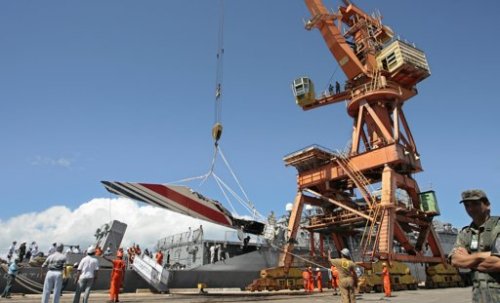WASHINGTON (AP) _ Are airline pilots forgetting how to fly? As planes become ever more reliant on automation to navigate crowded skies, safety officials worry there will be more deadly accidents traced to pilots who have lost their hands-on instincts in the air.

Hundreds of people have died over the past five years in “loss of control” accidents in which planes stalled during flight or got into unusual positions that pilots could not correct. In some cases, pilots made the wrong split-second decisions, with catastrophic results _ for example, steering the plane’s nose skyward into a stall instead of down to regain stable flight.
Spurred in part by U.S. regulations that require greater reliance on computerized flying, the airline industry is suffering from “automation addiction,” said Rory Kay, an airline captain and co-chairman of a Federal Aviation Administration committee on pilot training. “We‘re seeing a new breed of accident with these state-of-the art planes.”
Pilots use automated systems to fly airliners for all but about three minutes of a flight: the takeoff and landing. Most of the time pilots are programming navigation directions into computers rather than using their hands on controls to fly the plane.
That means they have few opportunities to maintain their skills by flying manually, Kay’s advisory committee warns.
Fatal airline accidents have decreased dramatically in the U.S. over the past decade. However, The Associated Press interviewed pilots, industry officials and aviation safety experts who expressed concern about the implications of decreased opportunities for manual flight, and reviewed more than a dozen loss-of-control accidents around the world.
A draft FAA study found pilots sometimes “abdicate too much responsibility to automated systems.” Because these systems are so integrated in today‘s planes, one malfunctioning piece of equipment or a single bad computer instruction can suddenly cascade into a series of other failures, unnerving pilots who have been trained to rely on the equipment.
The study examined 46 accidents and major incidents, 734 voluntary reports by pilots and others as well as data from more than 9,000 flights in which a safety official rode in the cockpit to observe pilots in action.
It found that in more than 60 percent of accidents, and 30 percent of major incidents, pilots had trouble manually flying the plane or made mistakes with automated flight controls.
A typical mistake was not recognizing that either the autopilot or the auto-throttle _ which controls power to the engines _ had disconnected. Others failed to take the proper steps to recover from a stall in flight or to monitor and maintain airspeed.
“We’re forgetting how to fly,” Kay said.
In the most recent fatal airline crash in the U.S., in 2009 near Buffalo, New York, the co-pilot of a regional airliner programmed incorrect information into the plane‘s computers, causing it to slow to an unsafe speed. That triggered a stall warning.
The startled captain, who hadn’t noticed the plane had slowed too much, responded by repeatedly pulling back on the control yoke, overriding two safety systems, when the correct procedure was to push forward. The plane plummeted to earth, killing all 49 people aboard and one on the ground.
Two weeks after the New York accident, a Turkish Airlines Boeing 737 crashed into a field while trying to land in Amsterdam. Nine people were killed and 120 injured. An investigation found that one of the plane‘s altimeters, which measures altitude, had fed incorrect information to the plane’s computers.
That, in turn, caused the auto-throttle to reduce speed to a dangerously slow level so that the plane lost lift and stalled.
Dutch investigators described the flight‘s three pilots’ “automation surprise” when they discovered the plane was about to stall. They hadn‘t been closely monitoring the airspeed.
Last month, French investigators recommended that all pilots get mandatory training in manual flying and handling a high-altitude stall. The recommendations were in response to the 2009 crash of an Air France jet flying from Brazil to Paris. All 228 people aboard were killed.
An investigation found that airspeed sensors fed bad information to the Airbus A330’s computers. That caused the autopilot to disengage suddenly and a stall warning to activate.
The co-pilot at the controls struggled to save the plane, but because he kept pointing the plane‘s nose up, he actually caused the stall instead of preventing it, experts said.
The ability of pilots to respond to the unexpected loss or malfunction of automated aircraft systems “is the big issue that we can no longer hide from in aviation,” said Bill Voss, president of the Flight Safety Foundation in Alexandria, Virginia. “We’ve been very slow to recognize the consequence of it and deal with it.”
The foundation, which is industry-supported, promotes aviation safety around the world.
<한글 기사>
비행기 조종사가 조종할 줄 모른다?
“자동 비행에 익숙‥수동 조종은 미숙”
“조종사들이 비행기를 조종할 줄 모른다면 어떻게 될까?”
자동항법장치를 이용한 항공기 운항이 일반화하면서 비상시 필요한 수동조종에 미숙한 조종사가 늘어 우려가 제기되고 있다고 AP 통신이 30일(미 동부 현지시각) 보도했다.
항공사 여객기 기장이자 미국 연방항공청(FAA) 자문위원회 공동의장인 로리 카 이는 “일부 규정에 따른 자동 운항 비율이 급증함에 따라 항공 업계가 ‘자동화 중독 ’을 앓고 있다”고 지적했다.
카이 의장은 “우리는 새로운 유형의 최첨단 비행기 사고를 목격하고 있다”면서 “조종사들이 점차 조종법을 잊고 있다”고 털어놨다.
자동항법장치를 이용하면 조종사들은 이륙과 착륙하는 3분 정도를 제외하고는 직접 조종간을 잡을 일이 없게 된다. 대부분은 컴퓨터에 필요한 자료만 입력하면 된 다.
이에 따라 조종사들이 직접 수동으로 조종하는 기능을 익힐 기회가 거의 없어졌 다는 게 카이 의장의 경고다.
FAA가 최근 46건의 사고와 주요 사건들, 734개의 조종사 보고서, 비행안전 관리 가 함께 탄 9천개 이상의 비행보고서를 대상으로 조사한 결과 조종사들이 자동항법 장치에 지나치게 의존하는 것으로 파악됐다.
자동항법장치에 너무 익숙해진 나머지 장치의 단순한 오작동이나 컴퓨터의 잘못 된 지시로 당황한 조종사들이 일련의 실수를 하게 된다는 것이다.
FAA 조사 결과에 따르면 전체 사고의 60% 이상, 주요 사건의 30% 이상에서 조종 사들의 수동 조종이나 자동항법장치 조작에 문제가 있었던 것으로 나타났다.
가장 전형적인 실수는 자동조종장치나 자동연료공급장치의 연결이 끊어졌다는 것을 인지하지 못하는 것과 항공기가 ‘실속(양력 상실)’ 상태에 빠졌을 때 적절한 조처를 하지 못해 비행 속도를 유지하지 못하는 경우다.
실제 2009년 미 뉴욕주 버펄로 인근 항공기 추락 사고나 네덜란드 암스테르담의 터키항공 여객기 추락 사고, 브라질 인근 대서양 해상에서의 에어프랑스 여객기 추락 사고 모두 이런 경우에 해당한다.
통신은 지난 5년간 수백 명이 비행기가 실속 하거나 조종사가 어떻게 할 수 없 는 통제 불능 사고로 목숨을 잃었으며 이 중 일부는 실속 상태에서 항공기 기수를 내리지 않고 오히려 올리는 것과 같은 조종사의 순간적인 판단 착오에 기인했다고 전했다.
미국 버지니아 알렉산드리아 소재 비행안전재단(FSF)의 빌 보스 이사장은 “자동 항법장치의 오작동과 같은 비상시 조종사의 대응 능력은 항공 업계에서 더는 숨길 수 없는 커다란 문제”라고 말했다. (연합뉴스)



![[Herald Interview] 'Amid aging population, Korea to invite more young professionals from overseas'](http://res.heraldm.com/phpwas/restmb_idxmake.php?idx=644&simg=/content/image/2024/04/24/20240424050844_0.jpg&u=20240424200058)















